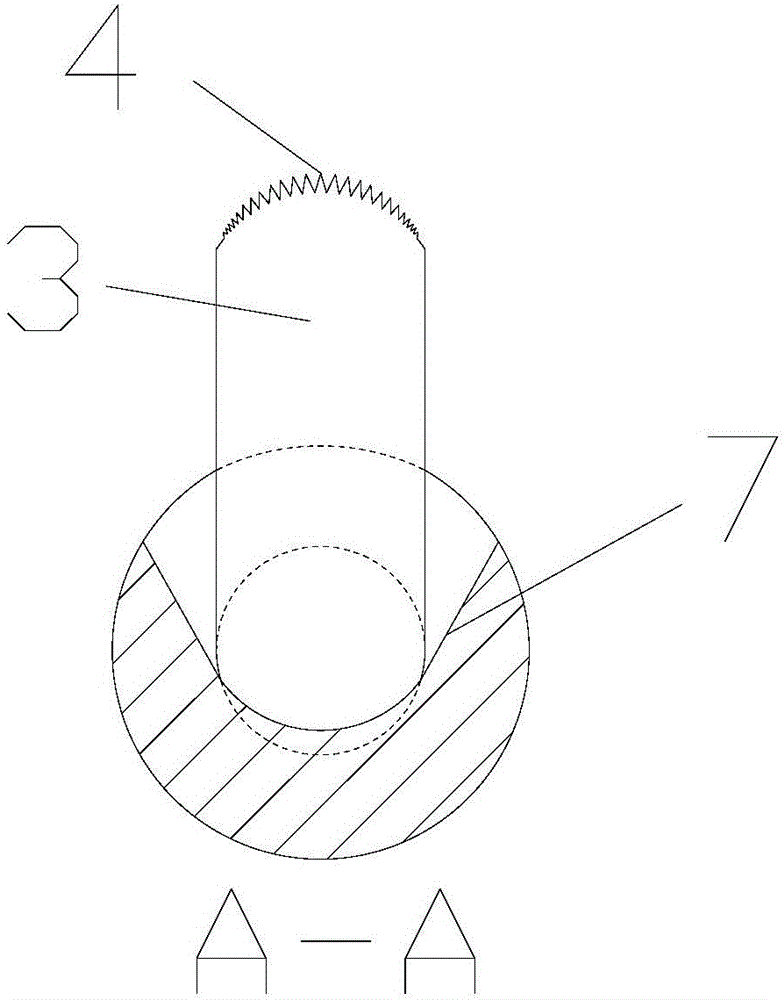Minimally-invasive transection device for pediculus arcus vertebrae
A pedicle and severing technology, which is used in medical science, surgical sawing, surgery, etc., can solve the problems of great harm, large axial jumping and radial shaking of cutting tools, and no guarantees, so as to reduce the need for surgery. The effect of risk, high adjustment accuracy and convenient operation
- Summary
- Abstract
- Description
- Claims
- Application Information
AI Technical Summary
Problems solved by technology
Method used
Image
Examples
Embodiment 1
[0027] Such as figure 1 , figure 2 with image 3 The shown minimally invasive pedicle severing device includes a saw core 1, a saw sheath 2, and a feeding mechanism,
[0028] The saw sheath 2 is in the shape of a round rod, and a circular hole is arranged axially in the body. The circular hole is radially contracted into a flat hole with a rectangular cross section on the two opposite sides close to the distal end of the saw sheath 2. The side wall of φ is bent and extends through the outer wall of the saw sheath 2;
[0029] The saw core 1 is in the shape of a round rod that matches the round hole provided in the saw sheath 2, and it penetrates the round hole in the saw sheath 2, and the proximal end extends beyond the proximal end of the saw sheath 2, and the diameter of the two opposite sides of the distal end Shrink to form a flat structure 3 with a rectangular cross section, the flat structure 3 matches the flat hole provided at the distal end of the saw sheath 2 and the end...
Embodiment 2
[0039] Such as Figure 5 The structure of another minimally invasive pedicle severing device shown is the same as that of Embodiment 1 except for the following description: it also includes a fixing frame 9 which is rod-shaped and has a mounting hole transversely in the middle. The proximal end of the sheath 2 is inserted and fixed in the mounting hole; the distal ends of the two elastic arms 6 are fixedly connected with the saw sheath 2 via a fixing frame, and the middle part of each elastic arm 6 is bent radially toward each other. The function of the fixing frame 9 is to make it easier to grip the saw sheath 2 or to fix the saw sheath 2. The use process of the minimally invasive pedicle severing device of Example 2 is basically the same as that of Example 1.
PUM
 Login to View More
Login to View More Abstract
Description
Claims
Application Information
 Login to View More
Login to View More - R&D
- Intellectual Property
- Life Sciences
- Materials
- Tech Scout
- Unparalleled Data Quality
- Higher Quality Content
- 60% Fewer Hallucinations
Browse by: Latest US Patents, China's latest patents, Technical Efficacy Thesaurus, Application Domain, Technology Topic, Popular Technical Reports.
© 2025 PatSnap. All rights reserved.Legal|Privacy policy|Modern Slavery Act Transparency Statement|Sitemap|About US| Contact US: help@patsnap.com



